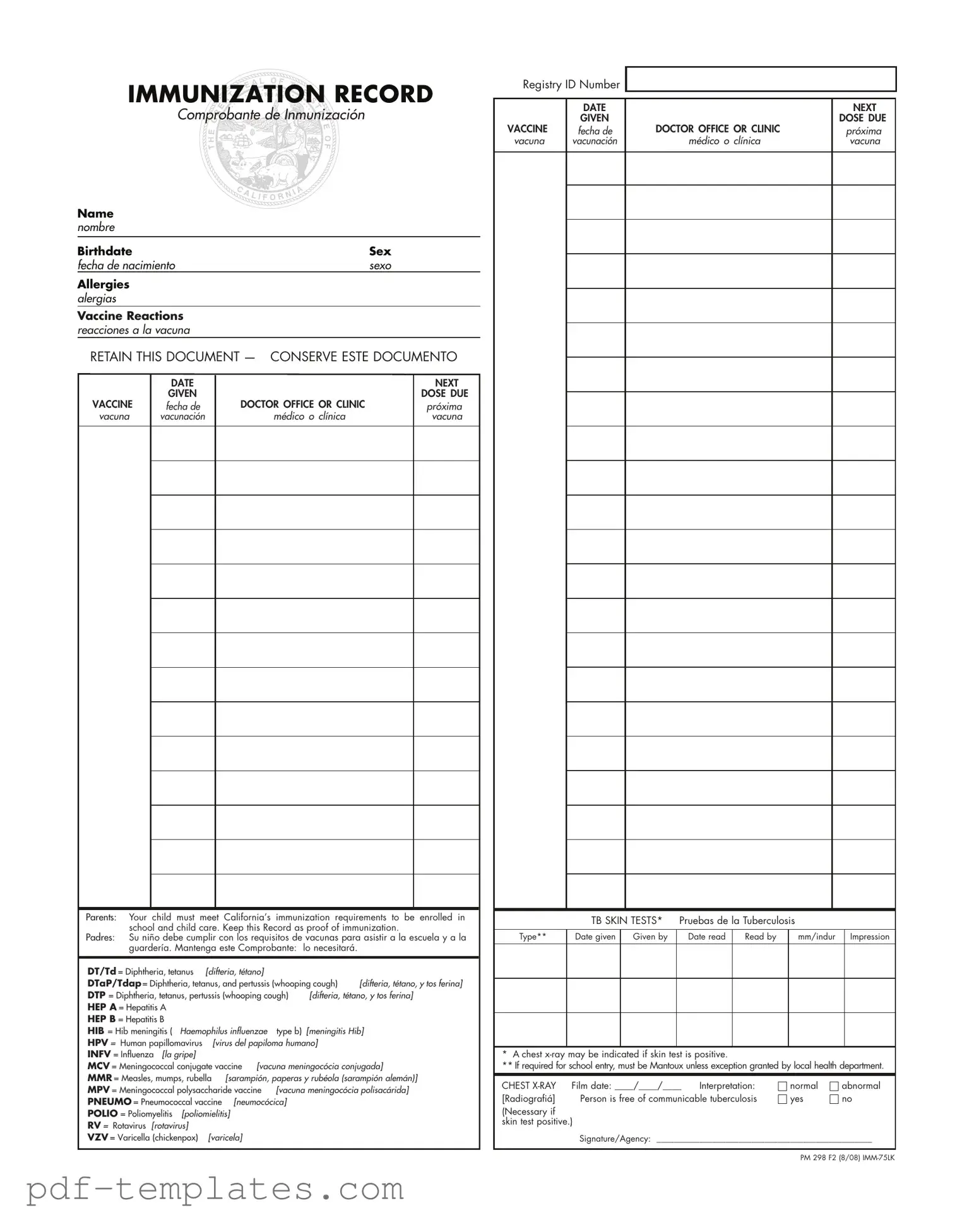The Immunization Record form shares similarities with the Health History form, which is often used in medical settings to compile an individual's past health information. Both documents collect crucial data about a person's medical background, including allergies and previous vaccine reactions. The Health History form typically asks for information regarding chronic conditions and past illnesses, providing a comprehensive view of the individual's health status. This holistic approach assists healthcare providers in making informed decisions about future vaccinations and treatments, similar to how the Immunization Record ensures compliance with vaccination requirements.
Another document akin to the Immunization Record is the School Health Assessment form. This form is generally required for students entering school and includes information about vaccinations, health screenings, and any ongoing medical conditions. Like the Immunization Record, the School Health Assessment serves as proof of compliance with state health regulations. It emphasizes the importance of vaccinations in preventing disease outbreaks within schools, ensuring that children are not only protected but also contributing to the overall health of their peers.
The Vaccine Information Statement (VIS) is another important document that parallels the Immunization Record. This statement provides essential information about specific vaccines, including their benefits and risks. While the Immunization Record tracks the vaccines received, the VIS educates parents and guardians about what each vaccine entails. Both documents work together to ensure that families are well-informed about immunizations, promoting transparency and understanding in the vaccination process.
Similarly, the Consent for Immunization form is closely related to the Immunization Record. This form is typically signed by a parent or guardian, granting permission for a child to receive vaccinations. It often includes information about the vaccines being administered, much like the Immunization Record. By documenting consent, this form ensures that parents are actively involved in their child's healthcare decisions, reinforcing the importance of informed consent in medical practices.
The Medical Exemption form also bears resemblance to the Immunization Record. This document is used when a child cannot receive certain vaccinations due to medical reasons. It requires a healthcare provider's signature, confirming the validity of the exemption. Both documents serve critical roles in the vaccination process, ensuring that children who cannot be vaccinated for health reasons are still accounted for in public health initiatives, thereby protecting the community at large.
Another document that mirrors the Immunization Record is the Travel Health Certificate. This certificate is often required for international travel and includes vaccination records specific to travel-related diseases. Just as the Immunization Record provides proof of vaccinations for school enrollment, the Travel Health Certificate verifies that an individual has received necessary vaccinations to enter certain countries. Both documents highlight the significance of vaccinations in maintaining public health, whether at school or abroad.
The California Agreement Room form is an essential document to ensure clarity in rental arrangements, particularly for room rentals in private residences. It outlines critical details such as rent payment schedules, property maintenance responsibilities, and the conditions under which the landlord may access the rented space. This form aims to protect both parties by establishing clear guidelines and responsibilities. For additional resources and documentation, you can refer to All California Forms.
The Patient Care Summary is another document that shares common ground with the Immunization Record. This summary provides an overview of a patient's health status, including immunization history. It is often used in healthcare settings to give providers a quick reference to a patient's vaccinations and medical history. By consolidating this information, the Patient Care Summary facilitates efficient healthcare delivery, similar to how the Immunization Record aids in monitoring vaccination compliance.
Lastly, the Child Health Record is comparable to the Immunization Record. This document is a comprehensive collection of a child's health information, including growth milestones, developmental assessments, and immunization history. Both records are essential for tracking a child's health over time, ensuring that they receive appropriate care and vaccinations as they grow. By maintaining these records, parents and healthcare providers can work together to promote the child's overall well-being.
